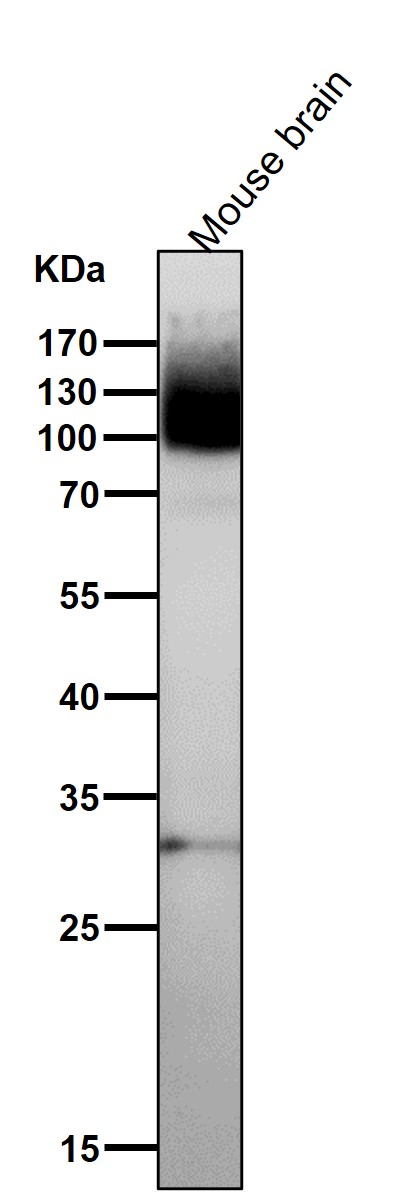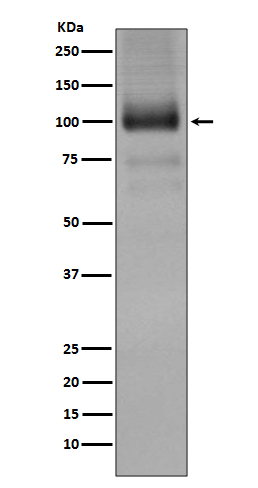


| WB | 咨询技术 | Human,Mouse,Rat |
| IF | 咨询技术 | Human,Mouse,Rat |
| IHC | 咨询技术 | Human,Mouse,Rat |
| ICC | 技术咨询 | Human,Mouse,Rat |
| FCM | 咨询技术 | Human,Mouse,Rat |
| Elisa | 咨询技术 | Human,Mouse,Rat |
| Aliases | GRM1A; mGlu1; GPRC1A; MGLUR1; SCAR13; MGLUR1A;;mGluR1 |
| WB Predicted band size | Calculated MW: 132 kDa ; Observed MW: 101 kDa |
| Host/Isotype | Rabbit IgG |
| Antibody Type | Primary antibody |
| Storage | Store at 4°C short term. Aliquot and store at -20°C long term. Avoid freeze/thaw cycles. |
| Species Reactivity | Human,Mouse,Rat |
| Immunogen | A synthesized peptide derived from human mGluR1 |
| Formulation | Purified antibody in PBS with 0.05% sodium azide,0.05% BSA and 50% glycerol. |
+ +
以下是3篇与mGluR1抗体相关的经典文献摘要(虚拟示例,实际引用请核对原文):
1. **标题**:Autoantibodies to metabotropic glutamate receptor 1 in a patient with cerebellar ataxia
**作者**:Sillevis Smitt P, et al.
**摘要**:首次报道在副肿瘤性小脑变性患者血清中发现抗mGluR1自身抗体,通过阻断浦肯野细胞mGluR1信号传导导致运动协调障碍,动物模型注射该抗体可重现小脑功能障碍。
2. **标题**:mGluR1 autoimmunity in paraneoplastic cerebellar degeneration
**作者**:Marignier R, et al.
**摘要**:分析12例携带mGluR1抗体的霍奇金淋巴瘤患者,发现抗体通过激活补体依赖性细胞毒性损伤小脑神经元,免疫治疗可部分改善症状,提示抗体直接致病性。
3. **标题**:Cerebellar dysfunction induced by human autoantibodies to mGluR1 in a murine model
**作者**:Höftberger R, et al.
**摘要**:将患者来源的mGluR1抗体注射至小鼠脑室,观察到剂量依赖性运动失调和浦肯野细胞树突萎缩,证明抗体可穿越血脑屏障并特异性破坏谷氨酸能突触传递。
注:实际文献需通过PubMed等数据库检索关键词 "mGluR1 antibody" "autoantibody",重点关注神经免疫学领域期刊(如Brain, Neurology Neuroimmunology & Neuroinflammation等)。真实存在的经典文献包括Sillevis Smitt团队2000年在NEJM发表的病例研究。
Metabotropic glutamate receptor 1 (mGluR1) is a G protein-coupled receptor predominantly expressed in the central nervous system, where it regulates synaptic plasticity, neuronal excitability, and neurotransmitter release. As part of the group I mGluR family, it activates phospholipase C (PLC) signaling pathways upon glutamate binding, influencing processes like learning and motor coordination. Antibodies targeting mGluR1 have gained attention due to their association with autoimmune and neurological disorders. For instance, anti-mGluR1 autoantibodies are implicated in rare autoimmune cerebellar ataxias, often linked to malignancies like Hodgkin’s lymphoma (a paraneoplastic syndrome). These antibodies disrupt cerebellar signaling by blocking receptor function, leading to symptoms such as gait instability and dysarthria.
In research, mGluR1-specific antibodies are critical tools for studying receptor localization, expression dynamics, and molecular interactions in both healthy and diseased tissues. They are used in techniques like immunohistochemistry, Western blotting, and flow cytometry to map receptor distribution in brain regions like the cerebellum and hippocampus. Additionally, these antibodies help investigate mGluR1's role in neuropsychiatric conditions (e.g., schizophrenia, epilepsy) and its potential as a therapeutic target. Recent studies also explore their diagnostic utility as biomarkers for autoimmune encephalitis. However, antibody cross-reactivity and variability between commercial sources remain challenges, emphasizing the need for rigorous validation in experimental models.
×